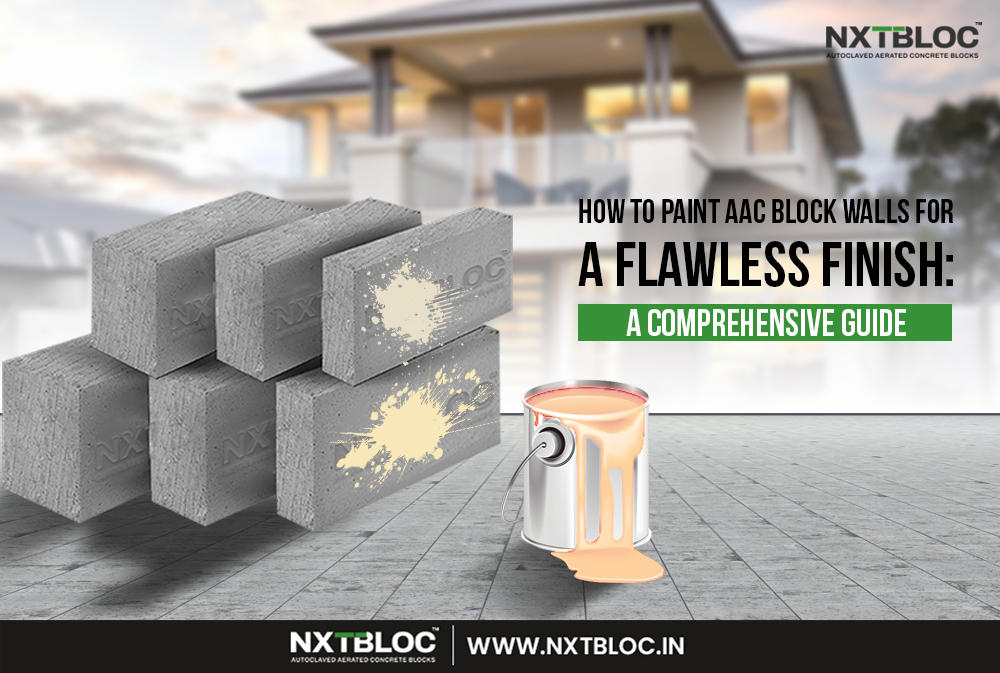Introduction
AAC blocks, or Autoclaved Aerated Concrete blocks, are rapidly gaining popularity in modern construction due to their lightweight nature, superior insulation properties, and ease of use. However, achieving a flawless finish on an AAC block wall requires specific painting techniques due to the unique properties of the material. This comprehensive guide by NXTBLOC, a leading manufacturer of high-quality AAC blocks, will equip professional painters and contractors with the valuable knowledge needed to paint AAC block walls for a stunning and long-lasting result.
Table of Contents
Understanding AAC Blocks and their Painting Requirements

AAC blocks are lightweight and possess a porous structure compared to traditional concrete or brick walls. This porosity can affect paint adhesion and selection. Additionally, a phenomenon called efflorescence—the migration of salts to the surface—can sometimes occur on AAC block walls. These factors necessitate specific considerations when choosing paint and preparing the wall surface.
Preparing AAC Block Walls for Painting
Before picking up a paintbrush, proper preparation is key to achieving a flawless finish on your AAC block wall. Here’s a detailed step-by-step guide:
- Surface Cleaning: Begin by thoroughly removing dust, dirt, and cobwebs from the wall. Address any mould or mildew issues with a suitable cleaning solution specifically formulated for masonry surfaces. Pay close attention to removing any surface contaminants that could hinder paint adhesion.
- Curing Time: Ensure the AAC block wall has undergone the recommended curing period, typically 28 days, before painting. This allows the material to fully dry and prevents moisture-related problems down the line. Painting on a non-fully cured wall can trap moisture and lead to peeling or blistering of the paint later.
- Filling Imperfections: Use a high-quality patching compound specifically formulated for AAC blocks to fill minor gaps or cracks on the surface. Choose a patching compound that dries quickly and sands easily to avoid delays in the painting process.
- Sanding: Once the patching material dries, sand the wall lightly with fine-grit sandpaper to create a smooth surface for better paint adhesion. Sanding also removes any laitance, a thin film that can sometimes form on the surface of new AAC block walls, ensuring the paint adheres directly to the block itself.
Selecting the Right Paint for AAC Block Walls
Not all paints are created equal. Here’s what to consider when choosing paint for AAC block walls:
- Paint Type: Opt for acrylic latex paints specifically designed for masonry surfaces. These paints offer excellent breathability, which allows the AAC block to release moisture vapour naturally, preventing moisture buildup behind the paint film.
- Porosity: Choose a paint with good hiding power to ensure even coverage in fewer coats. This is especially important due to the porosity of AAC blocks, which can absorb more paint than a non-porous surface.
- Weather Resistance: Consider the element exposure for the wall. Choose a paint with superior weather resistance for exterior walls. Exterior-grade paints typically contain additives that protect against UV rays, harsh weather conditions, and fading.
- Primer: Don’t skip the primer! Use a high-quality primer specifically designed for AAC blocks to further enhance paint adhesion and create a uniform base coat. A good primer can also help to seal the pores of the AAC block, reducing paint absorption and improving overall coverage.
Applying Paint to AAC Block Walls (The Painting Process)
Now that you’re armed with the right supplies, let’s get down to painting!
- Number of Coats: Apply two thin coats of paint for optimal coverage and a flawless finish. Thin coats are less likely to sag or drip, and they allow for better penetration into the AAC block surface.
- Application Techniques: Choose between spraying or rolling for even paint application. Spraying can be faster for large areas but requires practice to avoid overspray. Rolling provides a smoother finish and is easier to control for beginners.
- Brushing Techniques: Use a brush to clean lines around edges and corners. Maintain a light touch to avoid brush marks. Cutting in with a brush first ensures clean lines where the wall meets the ceiling, trim, or other surfaces.
- Drying Times: Allow for proper drying time between coats as specified by the paint manufacturer. Rushing the drying process can lead to cracking, peeling, or uneven finish.
Pro Tips for Achieving a Flawless Finish for AAC Block Walls
Here are some professional tips from NXTBLOC to elevate your AAC block wall painting project:
- Lighting: Paint in good lighting conditions, ideally natural light, to ensure even application and easy detection of imperfections. Good lighting allows you to see exactly how much paint is being applied and helps to avoid missed spots.
- Minimize Streaks: Overlapping your rolled sections by about half ensures a smooth, even coat and minimizes the appearance of streaks.
- Imperfection Camouflage: For a truly flawless finish, use light sanding between coats with fine-grit sandpaper. This smooths out any minor imperfections from the first coat and creates a surface for a perfect final coat.
Conclusion
Following these comprehensive steps and pro tips from NXTBLOC will ensure your AAC block walls receive a professional-looking paint job with a flawless finish. Remember, proper preparation and using the right paint and techniques are key to achieving a long-lasting and beautiful result.
NXTBLOC, a leading manufacturer of top-quality AAC blocks, is committed to providing valuable resources for builders and contractors.
